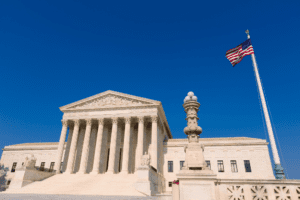 The dissent continued: But if the examples discussed above, taken together, do not show a tradition and history of regulation that supports the validity of New York’s law, what could? Sadly, I do not know the answer to that question. What is worse, the Court appears to have no answer either.
The dissent continued: But if the examples discussed above, taken together, do not show a tradition and history of regulation that supports the validity of New York’s law, what could? Sadly, I do not know the answer to that question. What is worse, the Court appears to have no answer either.
We are bound by Heller insofar as Heller interpreted the Second Amendment to protect an individual right to possess a firearm for self-defense. But Heller recognized that that right was not without limits and could appropriately be subject to government regulation. 554 U. S., at 626–627. Heller therefore does not require holding that New York’s law violates the Second Amendment. In so holding, the Court goes beyond Heller. It bases its decision to strike down New York’s law almost exclusively on its application of what it calls historical “analogical reasoning.” Ante, at 19–20.
As I have admitted above, I am not a historian, and neither is the Court. But the history, as it appears to me, seems to establish a robust tradition of regulations restricting the public carriage of concealed firearms. To the extent that any uncertainty remains between the Court’s view of the history and mine, that uncertainty counsels against relying on history alone. In my view, it is appropriate in such circumstances to look beyond the history and engage in what the Court calls means-end scrutiny. Courts must be permitted to consider the State’s interest in preventing gun violence, the effectiveness of the contested law in achieving that interest, the degree to which the law burdens the Second Amendment right, and, if appropriate, any less restrictive alternatives. The Second Circuit has previously done just that, and it held that New York’s law does not violate the Second Amendment. See Kachalsky, 701 F. 3d, at 101.
It first evaluated the degree to which the law burdens the Second Amendment right to bear arms. Id., at 93–94. It concluded that the law “places substantial limits on the ability of law-abiding citizens to possess firearms for self-defense in public,” but does not burden the right to possess a firearm in the home, where Heller said “‘the need for defense of self, family, and property is most acute.’” Kachalsky, 701 F. 3d, at 93–94 (quoting Heller, 554 U. S., at 628). The Second Circuit therefore determined that the law should be subject to heightened scrutiny, but not to strict scrutiny and its attendant presumption of unconstitutionality. 701 F. 3d, at 93–94. In applying such heightened scrutiny, the Second Circuit recognized that “New York has substantial, indeed compelling, governmental interests in public safety and crime prevention.” Id., at 97. I agree.
I expected the dissent would spend more time signaling to states like New Jersey how it could still restrict the public carriage of guns without violating the Supreme Court majority ruling in this case. IN New Jersey, efforts to do so have focused on the majority’s approval of prohibiting carriage in certain sensitive places. As of October 18, 2022, New Jersey’s Legislature is debating a bill that would require New Jersey gun owners to purchase liability insurance and prohibit them from carrying firearms in a wide range of places.
